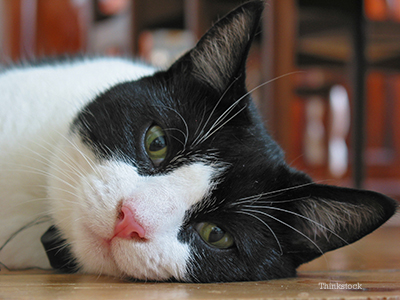
Dr. Justine Lee gives you the rundown of things you should look for when deciding whether to take your cat to the ER. For signs that your dog should visit the ER, click here.
Ah, cats. We love ‘em, but less so at two a.m. when they’re dry-heaving all over our carpet. What if your cat still continues to vomit multiple times all night? When do you decide to bring your cat into the ER? Can you wait to take Felix to your veterinarian in the morning?
My simple rule? If your cat is hiding, seek immediate veterinary advice.  Seriously. Hiding = bad. Cats hide their clinical signs of disease until it’s really severe, and by the time that you notice that they are hiding, it’s often really advanced, potentially end-stage disease.
Seriously. Hiding = bad. Cats hide their clinical signs of disease until it’s really severe, and by the time that you notice that they are hiding, it’s often really advanced, potentially end-stage disease.
Some sure signs to bring your cat to the ER include:
- Difficulty breathing (like open-mouth breathing, panting, or a respiratory rate over fifty breaths/minute [hint: count the number of breaths in fifteen seconds and multiple by four to get the total breaths per minute])
- Hiding (under the bed, in the closet)
- Not moving
- Straining or making multiple trips to the litter box
- Excessive grooming “back there” with the penis sticking out (seriously – this is really dangerous and is typically a feline urethral obstruction or urinary blockage, which I’ll talk about in a future blog)
- Lack of urine in the litter box for more than 36 hours
- Painful when picking up
- Profuse vomiting (more than 2-3 times in a night)
- Excessive drooling
- Sitting over the water bowl and not moving
- Seizuring or twitching
- Any kind of trauma
- Any kind of poisoning
- Any string hanging out of any orifice (For real. Please don’t pull and leave all orifices to veterinary professionals).
While this list isn’t complete, it’s a good initial guideline.
If you want to be the financial savvy owner (and I want you to be!), it’s best to go to your regular veterinarian before you end up with a more expensive emergency room visit. In other words, if you even have an inkling that something is wrong, better to go to your family veterinarian first rather than wait until Sunday night when your cat is really crashed out (leading to a more expensive hospitalization).
When in doubt, call your veterinarian or an emergency clinic for counsel on whether to bring your cat in for an emergency visit. In fact, when in doubt, you can even go into the emergency room and potentially asked to be triaged (to make sure your cat is stable). Not all clinics will offer this, but I always have in the past as an emergency doctor. This is particularly important if you’re not sure if your cat has a urinary obstruction. Simply allow the emergency veterinarian to cop a feel of your cat’s bladder, and voila… if they don’t think your cat is blocked, they may “triage” you away to your family vet the next day.
When in doubt, it’s always safer to heed the side of caution, right? You won’t regret playing it too safe with your fuzzy feline.
Anyone out there have a different emergency to share about your cat?
If you have any questions or concerns, you should always visit or call your veterinarian – they are your best resource to ensure the health and well-being of your pets.
